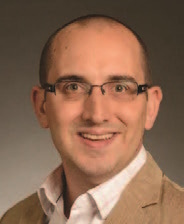Cognitive Disengagement Syndrome
Joseph W. Fredrick
Download PDF
Cognitive Disengagement Syndrome: What Is It and How Is It Different from ADHD?
Attention difficulties are common in children and adolescents with ADHD. They include trouble staying focused, being easily distracted, rushing through schoolwork, losing materials or being forgetful, and disorganization. Due to these difficulties, children and adolescents with ADHD struggle with starting and completing tasks, such as chores and homework.

However, attention difficulties do not look the same in every person, including among children and adolescents diagnosed with ADHD. There are also some children who are often distracted by what is going on in their own minds—they frequently daydream, get lost in their thoughts, and often seem to be working or moving at a slower pace than other children. Rather than being hyperactive or restless, these children are sleepy, appear confused, and take longer to finish activities.
This combination of behaviors, termed cognitive disengagement syndrome (CDS) and previously called sluggish cognitive tempo, is present in 25-40% of children and adolescents with ADHD. This article will discuss the key differences of CDS and the attention difficulties that are typically seen in ADHD.
1 Children and adolescents with CDS appear to be “internally distracted.”Compared to children and adolescents with ADHD who often struggle with being easily distracted by external stimuli and being off-task, many of the attention difficulties in CDS are a result of being “disengaged” from the current environment. These children and teens may experience mind-wandering or daydreaming, getting lost in their thoughts, and zoning or spacing out.
In in-depth interviews, parents with a child elevated in CDS used various terms to describe their child’s behaviors, including “daydreaming,” “own little world,” “la-la land,” “zoned out,” and “in another world.” This can cause a lot of challenges, especially with school.
Imagine two children. One child with ADHD is often distracted by other students talking, rushes through work making careless mistakes, and struggles with organizing materials. This child’s attention difficulties are obvious. The second child “appears” to be paying attention, but their mind is wandering about other thoughts or they are spacing out. This child’s difficulties with attention is harder to recognize.
2 Rather than being hyperactive or restless, children and adolescents with CDS are sleepy, lethargic, and have trouble remaining alert.
In addition to being internally distracted, children and adolescents with CDS are often described as being “slow-moving,” “tired,” or “needing extra time to complete activities.” Rather than taking longer to complete homework because of being distracted and rushing through, the pace at which children with CDS move and complete activities is often much slower.
In the same interview study mentioned above, families also noted that CDS behaviors make daily tasks take far longer than they should, like doing chores (“it takes him so long to do the dishes”) or getting ready in the morning (“it takes her awhile to get moving and that’s why I get her up so early”).
3 Children and adolescents with CDS are at higher risk for anxiety, depression, social withdrawal, and sleep problems.
One of the clear differences between ADHD and CDS involves their links to other mental health difficulties. Children and adolescents with ADHD are more likely to experience externalizing behaviors, which include temper loss, argumentativeness, noncompliance, and so forth. However, CDS appears to place children and adolescents at-risk for experiencing anxiety, depression, social withdrawal, and difficulties falling and staying asleep.
Even among children with ADHD, CDS symptoms are associated with more anxious and depressed symptoms. Children elevated in CDS have also been found to spend more time alone and disengaged from peers at recess compared to same-aged peers. There might be many reasons, but it is likely that children and adolescents with CDS may feel more anxious in social situations, have a hard time with social skills, or prefer to engage in individual leisurely activities.
Future directions for treatment
If you believe your child or teen experiences CDS, you might be wondering, “Okay, but how do I help my child?” One of the biggest issues facing families of children with CDS is the lack of research on treatment options for CDS. Initial research suggests that atomoxetine medication, organization and homework training, and behavioral parent training may help decrease CDS behaviors. Our research and the stories and challenges that families have shared with us encouraged us to develop the first CDS clinical service offered through the Cincinnati Children’s Center for ADHD.
The Cincinnati Children’s Cognitive Disengagement Syndrome Program offers comprehensive evaluation of CDS and behavioral treatment services for children and adolescents ages six to seventeen. The evaluation consists of two or three appointments: an interview with the parent, an interview/meeting with the child, and feedback sharing (including an evaluation report). The goal is to determine whether CDS in part explains the child’s current concerns, while also evaluating mental health problems like ADHD, anxiety, depression, etc.
Treatment services include a range of evidence-based treatments, such as behavioral parent training, school-based resources, mindfulness meditation, behavioral sleep interventions, and social skills training. These services can be provided in person or via telehealth to families in certain states.
FOR MORE INFO
To learn more, visit the CDS Specialty Service website at www.cincinnatichildrens.org/service/c/adhd/services/cds or contact them by telephone at (513) 636-4336.
 Joseph William Fredrick, PhD, is an assistant professor of pediatrics at Cincinnati Children’s Hospital Medical Center and University of Cincinnati College of Medicine. His clinical work focuses on assessment and treatment of ADHD and co-occurring problems, including cognitive disengagement syndrome (CDS). He leads the CDS specialty service at Cincinnati Children’s Hospital which provides evaluation and treatment for CDS.
Joseph William Fredrick, PhD, is an assistant professor of pediatrics at Cincinnati Children’s Hospital Medical Center and University of Cincinnati College of Medicine. His clinical work focuses on assessment and treatment of ADHD and co-occurring problems, including cognitive disengagement syndrome (CDS). He leads the CDS specialty service at Cincinnati Children’s Hospital which provides evaluation and treatment for CDS.
 Stephen P. Becker, PhD, is an associate professor of pediatrics, director of research, and endowed chair in the division of behavioral medicine and clinical psychology at Cincinnati Children’s Hospital Medical Center. His research, funded by the National Institute of Mental Health and the Institute of Education Sciences, focused on cognitive disengagement syndrome and sleep problems in children and adolescents with ADHD.
Stephen P. Becker, PhD, is an associate professor of pediatrics, director of research, and endowed chair in the division of behavioral medicine and clinical psychology at Cincinnati Children’s Hospital Medical Center. His research, funded by the National Institute of Mental Health and the Institute of Education Sciences, focused on cognitive disengagement syndrome and sleep problems in children and adolescents with ADHD.
ADDITIONAL READING
Becker, S. P., Marshall, S. A., & McBurnett, K. (2014). Sluggish cognitive tempo in abnormal child psychology: An historical overview and introduction to the special section. Journal of Abnormal Child Psychology, 42(1), 1-6.
Becker, S. P., Fredrick, J. W., Foster, J. A., Yeaman, K. M., Epstein, J. N., Froehlich, T. E., & Mitchell, J. T. (2022). “My mom calls it Annaland”: A qualitative study of phenomenology, daily life impacts, and treatment considerations of sluggish cognitive tempo. Journal of Attention Disorders, 26, 915-931. doi:10.1177/10870547211050946
Becker, S. P., Willcutt, E. G., Leopold, D. R., Fredrick, J. W., Smith, Z. R., Jacobson, L. A., … & Barkley, R. A. (2022). Report of a Work Group on sluggish cognitive tempo: Key research directions and a consensus change in terminology to cognitive disengagement syndrome. Journal of the American Academy of Child & Adolescent Psychiatry. Advance online publication. doi:10.1016/j.jaac.2022.07.821
Fredrick, J. W., & Becker, S. P. (2023). Cognitive disengagement syndrome (sluggish cognitive tempo) and social withdrawal: Advancing a conceptual model to guide future research. Journal of Attention Disorders, 27, 38-45. doi:10.1177/10870547221114602
Other Articles in this Edition
The Challenge of Keeping Friends
Is ADHD Related to Eating Difficulties?
Cognitive Disengagement Syndrome
EpicWin as Game-Based Self-Management
Why Are Black Preschoolers with ADHD Expelled?
Launching Successful Young Adults with ADHD
Beware These Sneaky Energy Vampires
How I Manage My Improv-Based Training Business with ADHD
